Abstract
The human bladder carcinoma cell line 5637 produces hematopoietic growth factors [granulocyte and granulocyte/macrophage colony-stimulating factors (G-CSF and GM-CSF)] and hemopoietin 1, which synergizes with CSFs to stimulate colony formation by primitive hematopoietic stem cells in 5-fluorouracil-treated mouse bone marrow. Molecular and functional properties of hemopoietin 1 identified it as identical to interleukin 1 alpha (IL-1 alpha). When bone marrow cells from 5-fluorouracil-treated mice were cultured in suspension for 7 days with recombinant human IL-1 alpha and/or G-CSF, it was found that the two factors synergized to enhance recovery of myelopoietic cells and colony-forming cells of both high and low proliferative potential. G-CSF alone did not sustain these populations, but the combination had greater-than-additive stimulating capacity. In vivo, 5-fluorouracil (150 mg/kg) produced profound myelosuppression and delayed neutrophil regeneration for up to 2 weeks in C3H/HeJ mice. Daily administration of recombinant human G-CSF or recombinant human IL-1 alpha accelerated recovery of stem cells, progenitor cells, and blood neutrophils by up to 4 days in 5-fluorouracil-treated C3H/HeJ and B6D2F1 mice. The combination of IL-1 alpha and G-CSF acted synergistically, reducing neutropenia and accelerating recovery of normal neutrophil numbers by up to 7 days. This was accompanied by accelerated regeneration of spleen colony-forming units and erythroid, myeloid, and megakaryocytic progenitor cells in marrow and spleen, with enhanced erythroid and granulocytic differentiation. These results indicate the possible therapeutic potential of combination therapy with IL-1 and hematopoietic growth factors such as G-CSF in the treatment of chemotherapy- or radiation-induced myelosuppression.
Full text
PDF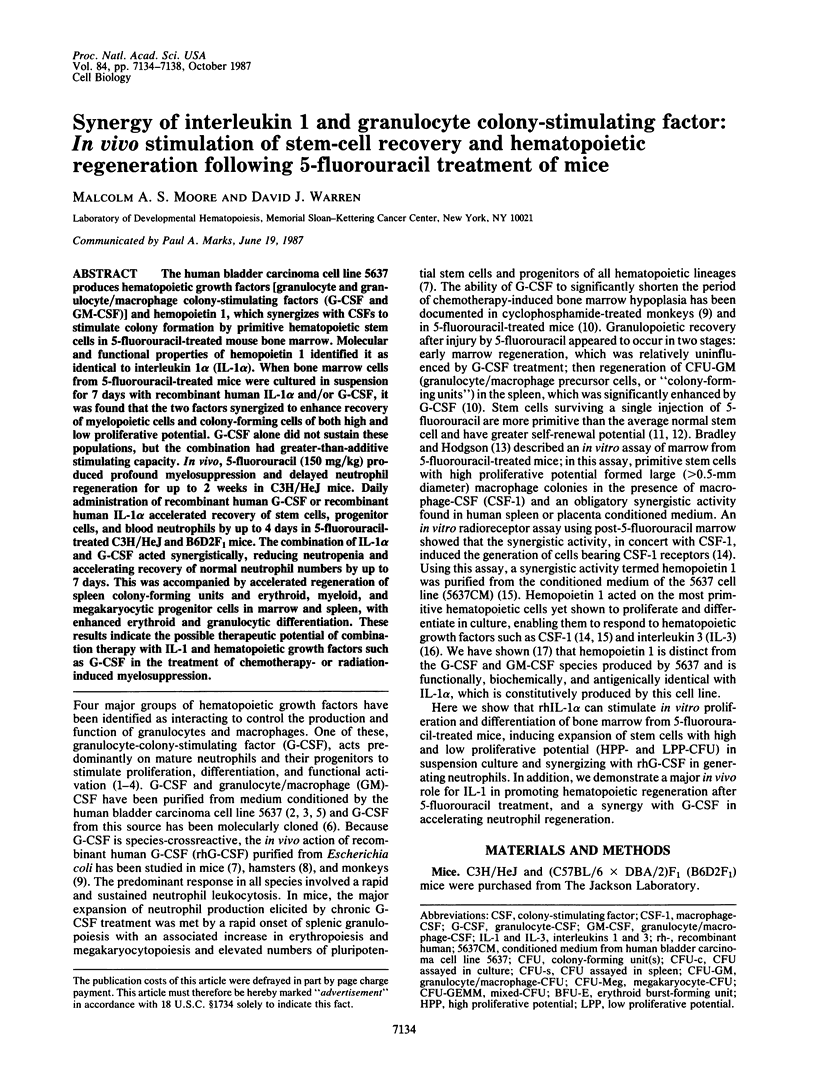
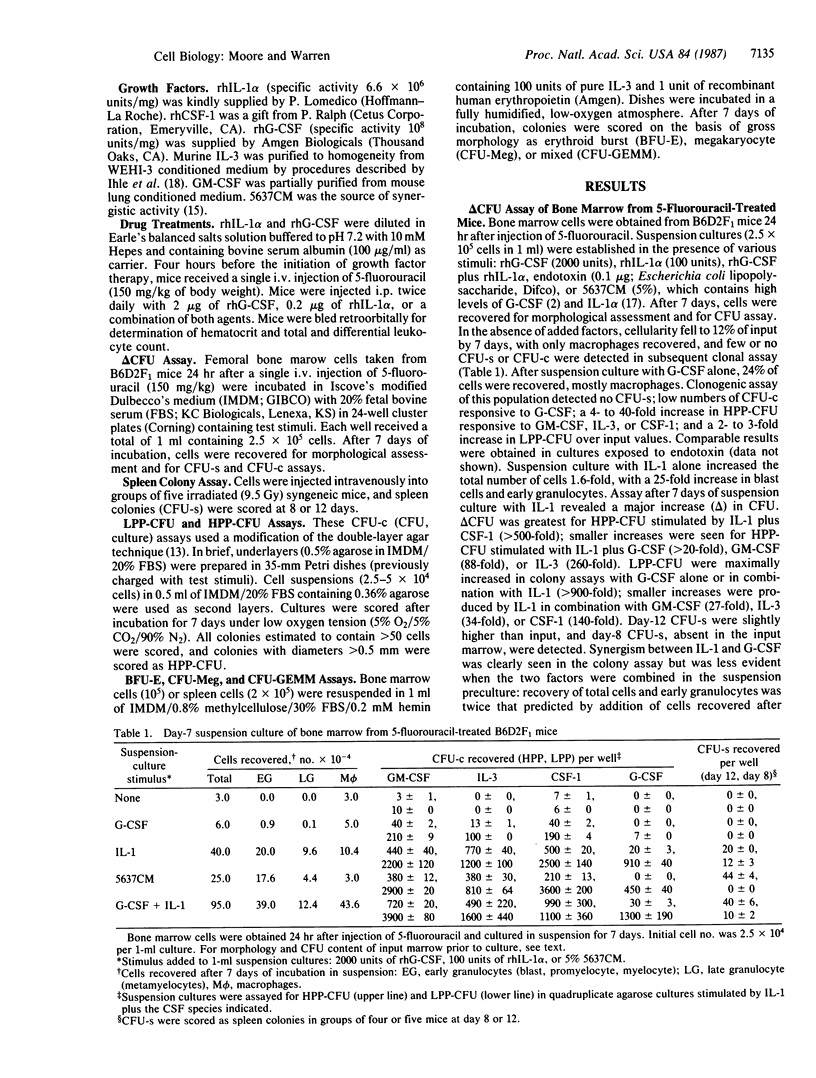
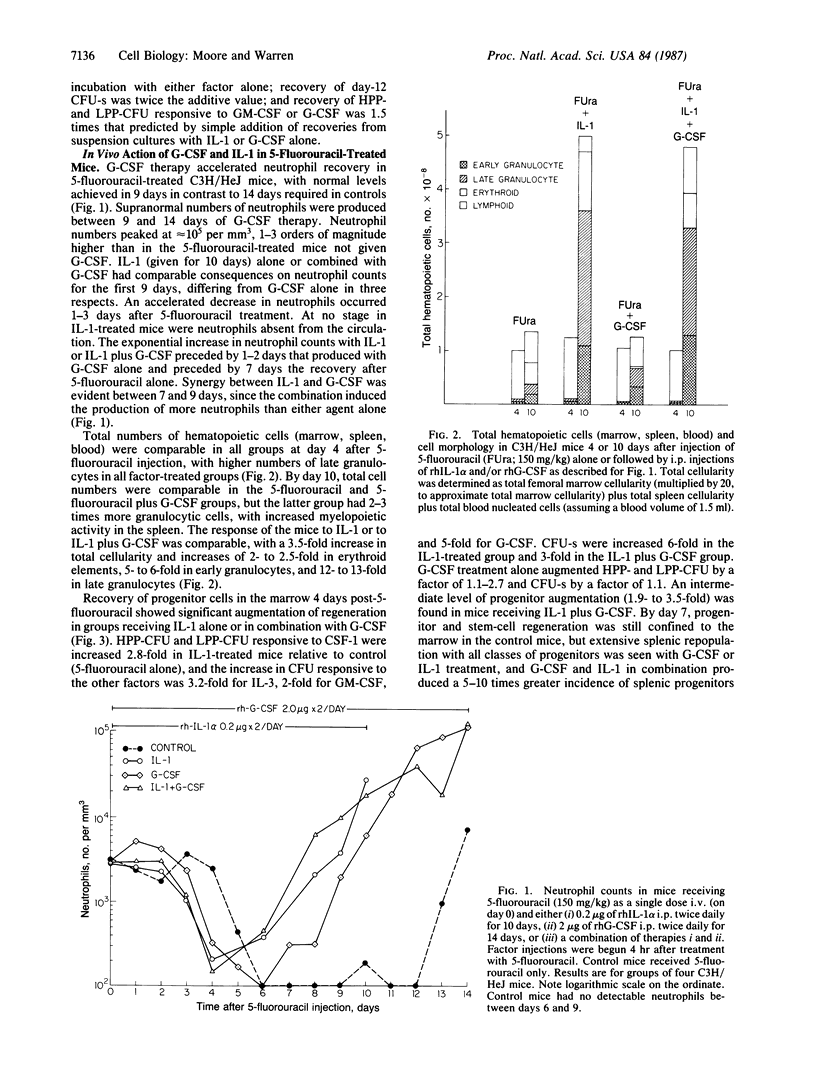
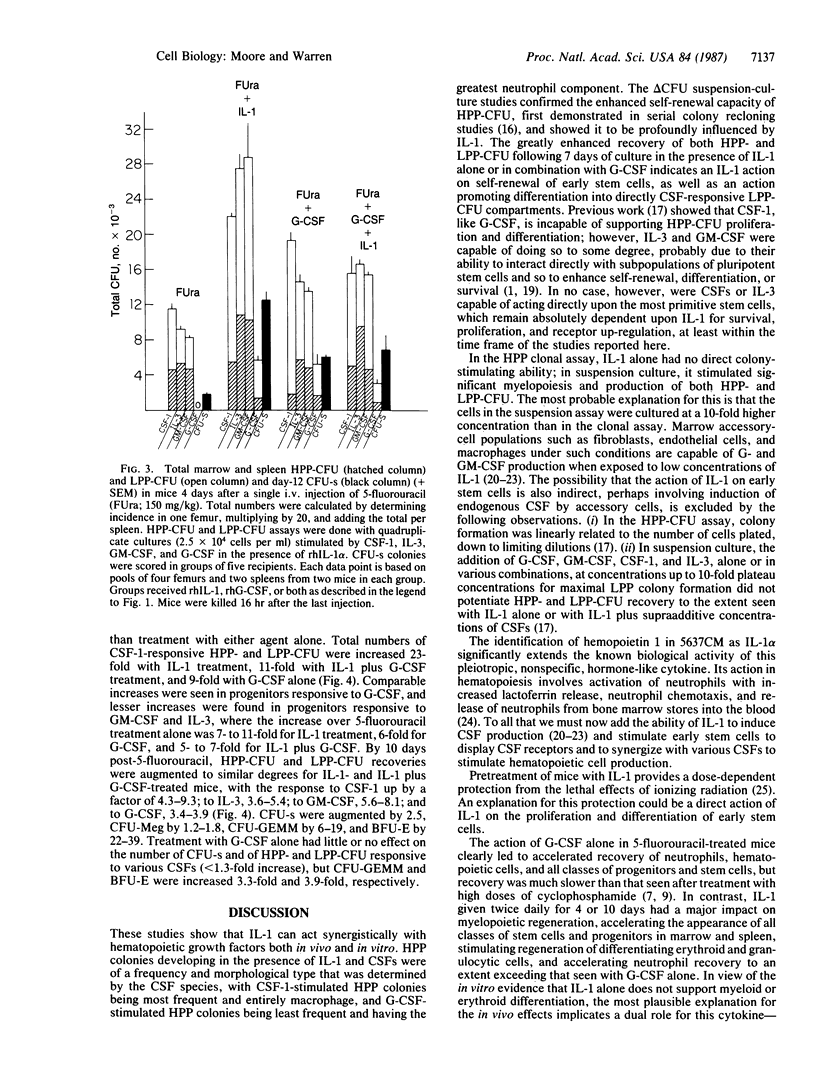
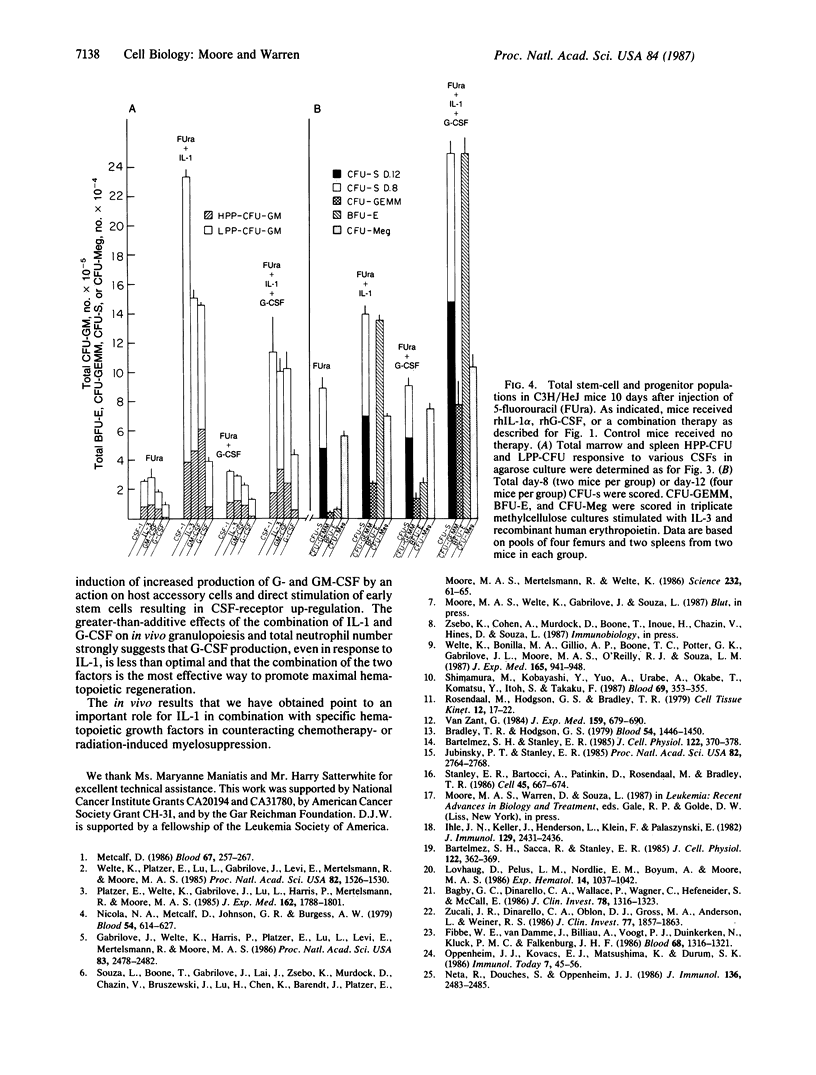
Selected References
These references are in PubMed. This may not be the complete list of references from this article.
- Bagby G. C., Jr, Dinarello C. A., Wallace P., Wagner C., Hefeneider S., McCall E. Interleukin 1 stimulates granulocyte macrophage colony-stimulating activity release by vascular endothelial cells. J Clin Invest. 1986 Nov;78(5):1316–1323. doi: 10.1172/JCI112717. [DOI] [PMC free article] [PubMed] [Google Scholar]
- Bartelmez S. H., Sacca R., Stanley E. R. Lineage specific receptors used to identify a growth factor for developmentally early hemopoietic cells: assay of hemopoietin-2. J Cell Physiol. 1985 Mar;122(3):362–369. doi: 10.1002/jcp.1041220305. [DOI] [PubMed] [Google Scholar]
- Bartelmez S. H., Stanley E. R. Synergism between hemopoietic growth factors (HGFs) detected by their effects on cells bearing receptors for a lineage specific HGF: assay of hemopoietin-1. J Cell Physiol. 1985 Mar;122(3):370–378. doi: 10.1002/jcp.1041220306. [DOI] [PubMed] [Google Scholar]
- Bradley T. R., Hodgson G. S. Detection of primitive macrophage progenitor cells in mouse bone marrow. Blood. 1979 Dec;54(6):1446–1450. [PubMed] [Google Scholar]
- Fibbe W. E., van Damme J., Billiau A., Voogt P. J., Duinkerken N., Kluck P. M., Falkenburg J. H. Interleukin-1 (22-K factor) induces release of granulocyte-macrophage colony-stimulating activity from human mononuclear phagocytes. Blood. 1986 Dec;68(6):1316–1321. [PubMed] [Google Scholar]
- Gabrilove J. L., Welte K., Harris P., Platzer E., Lu L., Levi E., Mertelsmann R., Moore M. A. Pluripoietin alpha: a second human hematopoietic colony-stimulating factor produced by the human bladder carcinoma cell line 5637. Proc Natl Acad Sci U S A. 1986 Apr;83(8):2478–2482. doi: 10.1073/pnas.83.8.2478. [DOI] [PMC free article] [PubMed] [Google Scholar]
- Ihle J. N., Keller J., Henderson L., Klein F., Palaszynski E. Procedures for the purification of interleukin 3 to homogeneity. J Immunol. 1982 Dec;129(6):2431–2436. [PubMed] [Google Scholar]
- Jubinsky P. T., Stanley E. R. Purification of hemopoietin 1: a multilineage hemopoietic growth factor. Proc Natl Acad Sci U S A. 1985 May;82(9):2764–2768. doi: 10.1073/pnas.82.9.2764. [DOI] [PMC free article] [PubMed] [Google Scholar]
- Løvhaug D., Pelus L. M., Nordlie E. M., Bøyum A., Moore M. A. Monocyte-conditioned medium and interleukin 1 induce granulocyte-macrophage colony-stimulating factor production in the adherent cell layer of murine bone marrow cultures. Exp Hematol. 1986 Dec;14(11):1037–1042. [PubMed] [Google Scholar]
- Metcalf D. The molecular biology and functions of the granulocyte-macrophage colony-stimulating factors. Blood. 1986 Feb;67(2):257–267. [PubMed] [Google Scholar]
- Neta R., Douches S., Oppenheim J. J. Interleukin 1 is a radioprotector. J Immunol. 1986 Apr 1;136(7):2483–2485. [PubMed] [Google Scholar]
- Nicola N. A., Metcalf D., Johnson G. R., Burgess A. W. Separation of functionally distinct human granulocyte-macrophage colony-stimulating factors. Blood. 1979 Sep;54(3):614–627. [PubMed] [Google Scholar]
- Platzer E., Welte K., Gabrilove J. L., Lu L., Harris P., Mertelsmann R., Moore M. A. Biological activities of a human pluripotent hemopoietic colony stimulating factor on normal and leukemic cells. J Exp Med. 1985 Dec 1;162(6):1788–1801. doi: 10.1084/jem.162.6.1788. [DOI] [PMC free article] [PubMed] [Google Scholar]
- Rosendaal M., Hodgson G. S., Bradley T. R. Organization of haemopoietic stem cells: the generation-age hypothesis. Cell Tissue Kinet. 1979 Jan;12(1):17–29. doi: 10.1111/j.1365-2184.1979.tb00110.x. [DOI] [PubMed] [Google Scholar]
- Shimamura M., Kobayashi Y., Yuo A., Urabe A., Okabe T., Komatsu Y., Itoh S., Takaku F. Effect of human recombinant granulocyte colony-stimulating factor on hematopoietic injury in mice induced by 5-fluorouracil. Blood. 1987 Jan;69(1):353–355. [PubMed] [Google Scholar]
- Souza L. M., Boone T. C., Gabrilove J., Lai P. H., Zsebo K. M., Murdock D. C., Chazin V. R., Bruszewski J., Lu H., Chen K. K. Recombinant human granulocyte colony-stimulating factor: effects on normal and leukemic myeloid cells. Science. 1986 Apr 4;232(4746):61–65. doi: 10.1126/science.2420009. [DOI] [PubMed] [Google Scholar]
- Stanley E. R., Bartocci A., Patinkin D., Rosendaal M., Bradley T. R. Regulation of very primitive, multipotent, hemopoietic cells by hemopoietin-1. Cell. 1986 Jun 6;45(5):667–674. doi: 10.1016/0092-8674(86)90781-6. [DOI] [PubMed] [Google Scholar]
- Van Zant G. Studies of hematopoietic stem cells spared by 5-fluorouracil. J Exp Med. 1984 Mar 1;159(3):679–690. doi: 10.1084/jem.159.3.679. [DOI] [PMC free article] [PubMed] [Google Scholar]
- Welte K., Bonilla M. A., Gillio A. P., Boone T. C., Potter G. K., Gabrilove J. L., Moore M. A., O'Reilly R. J., Souza L. M. Recombinant human granulocyte colony-stimulating factor. Effects on hematopoiesis in normal and cyclophosphamide-treated primates. J Exp Med. 1987 Apr 1;165(4):941–948. doi: 10.1084/jem.165.4.941. [DOI] [PMC free article] [PubMed] [Google Scholar]
- Welte K., Platzer E., Lu L., Gabrilove J. L., Levi E., Mertelsmann R., Moore M. A. Purification and biochemical characterization of human pluripotent hematopoietic colony-stimulating factor. Proc Natl Acad Sci U S A. 1985 Mar;82(5):1526–1530. doi: 10.1073/pnas.82.5.1526. [DOI] [PMC free article] [PubMed] [Google Scholar]
- Zucali J. R., Dinarello C. A., Oblon D. J., Gross M. A., Anderson L., Weiner R. S. Interleukin 1 stimulates fibroblasts to produce granulocyte-macrophage colony-stimulating activity and prostaglandin E2. J Clin Invest. 1986 Jun;77(6):1857–1863. doi: 10.1172/JCI112512. [DOI] [PMC free article] [PubMed] [Google Scholar]


